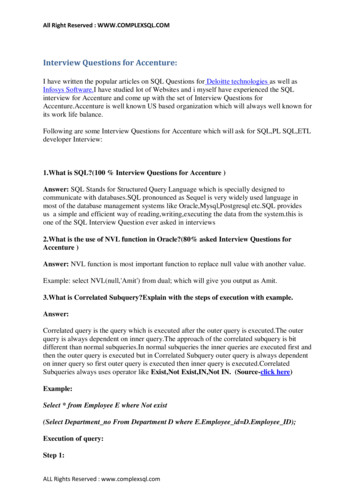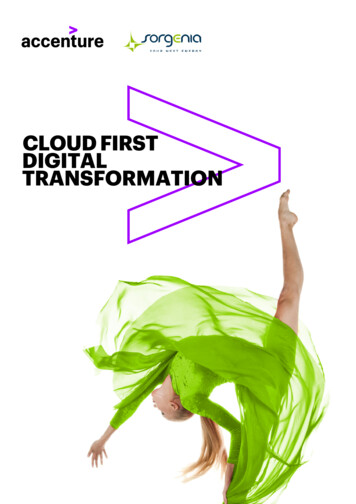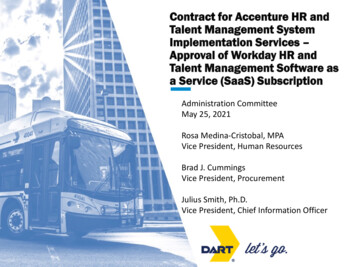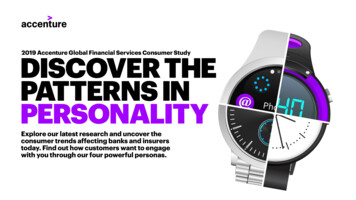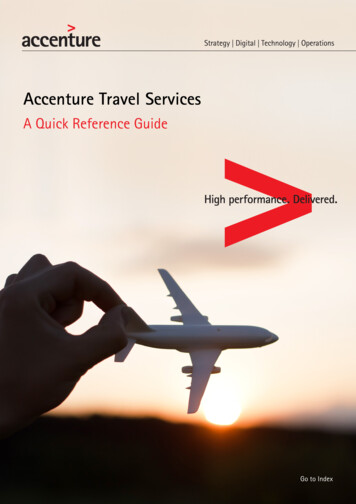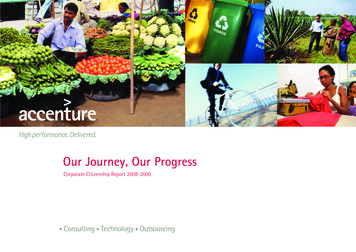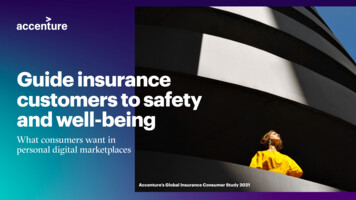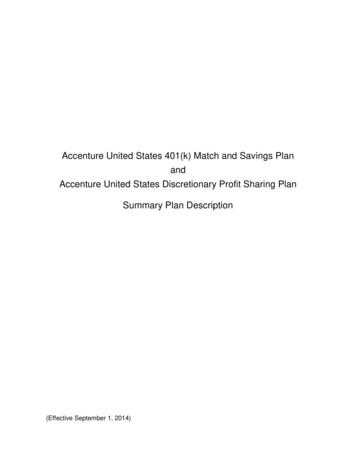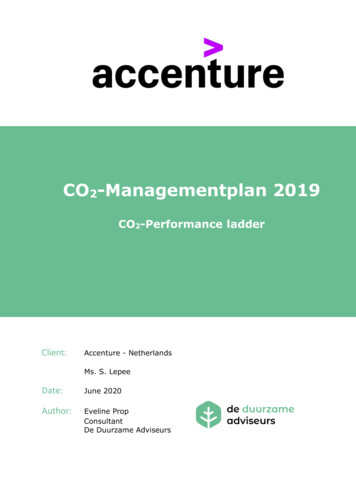
Transcription
CO2-ManagementplanAccenture.CO2-Managementplan 2019CO2-Performance ladderClient:Accenture - NetherlandsMs. S. LepeeDate:June 2020Author:Eveline PropConsultantDe Duurzame Adviseurs
Table of contentsCLIENT: . 1TABLE OF CONTENTS . 21 INTRODUCTION . 41.12 DESCRIPTION OF THE ORGANIZATION . 62.12.22.33READING GUIDE . 5POLICY STATEMENT . 6STATEMENT COMPANY SIZE . 6TENDERS WITH AWARD ADVANTAGE . 7 EMISSION-INVENTORY REPORT . 83.1RESPONSIBLE ACTOR . 83.2REFERENCE YEAR . 83.3ORGANIZATIONAL BOUNDARY . 83.4DIRECT AND INDIRECT GHG-EMISSIONS . 83.4.1Calculated GHG-emissions . 83.4.2Combustion of biomass . 93.4.3GHG-removal . 93.4.4Exceptions . 93.4.5Key influencers. 93.4.6Future . 93.4.7Significant changes . 93.5QUANTIFICATION METHODS . 93.6EMISSION FACTORS . 93.7UNCERTAINTIES . 93.8EXCLUSIONS . 103.9VERIFICATION . 103.10 STATEMENT IN ACCORDANCE WITH ISO 14064-1. 114 ENERGY MANAGEMENT ACTION PROGRAMME . 124.1QUALITY MANAGEMENT PLAN . 124.2ENERGY MANAGEMENT PLAN . 124.3ENERGY POLICY . 124.4GOALS . 134.5EXECUTION . 134.5.1Energy aspects . 134.5.2Reference year . 134.5.3Reduction measures. 134.5.4Organisation of the CO2-footprint. 134.5.5Energy consumption Accenture . 144.5.6Energy reduction opportunities . 144.5.7Monitoring and evaluating . 144.5.8Source and actionplan CO2-emissions . 154.6TRA MATRIX . 164.7SECURING THE QUALITY- AND ENERGY MANAGEMENT PLAN . 174.7.1Internal audits . 174.7.2External audits . 174.7.3Management review. 174.7.4Feedback . 175 CONTINUOUS IMPROVEMENT . 186 COMMUNICATION STRATEGY. 19CO2-Managementplan2
6.1EXTERNAL STAKEHOLDERS . 196.2INTERNAL STAKEHOLDERS . 196.3TENDERS WITH AWARD ADVANTAGE . 206.4COMMUNICATION STRATEGY . 216.5WEBSITE . 226.5.1Textual information. 226.5.2Shared documents . 226.5.3Website SKAO . 22CO2-Managementplan3
1 IntroductionAccenture provides (directly or indirectly) products and services to commissioning partieswho occasionally use award advantage in their tenders, based on the principles of theCO2-performance ladder. For Accenture these clients are predominantly private railwayparties and semi-governmental organizations. The CO2-performance ladder challengesand stimulates suppliers to map and reduce their own CO2-emissions. The more attentiona company pays to reducing their CO2, the higher the chance of receiving fictionaladvantage in a tender.The CO2-performance ladder is based on four pillars:A. InsightDrawing up an undisputable CO2-footprint in accordance with the ISO 14064-1norm to provide insight in the CO2-emissions of the company.B. CO2-reductionThe ambition of the company to reduce the CO2-emmissions.C. TransparencyThe way a company communicates about their CO2-footprint and reductionmeasures, both internally and externally.D. Participation(in sector and/or value chain initiatives) to reduce CO2-emissions.Every pillar of the CO2-Performance Ladder has five levels, ascending from 1 to 5. Ahigher level on the ladder will provide a higher award advantage in tenders. The activitiesare being assessed by an authorised certifying organization to determine the level on theCO2-Performance Ladder. To achieve a certain level, actions have to be taken on everypillar of the ladder. In order to do so, steps have to be made on every pillar of theladder.This report deals with the emissions-inventory of Accenture. This document focusses onaspect A (insight) and aspect B (CO2-reduction) of the CO2-performance ladder.The CO2-footprint provides an overview of the total greenhouse gas emissions: the GHGemissions. This also provides insights to the origin of these emissions with a distinction ofdirect and indirect GHG-emissions (respectively scope 1 and scope 2).The overview is a justification of requirement 3.A.1 van de CO2-Prestatieladder and hasbeen conducted in accordance with ISO 14064-1: 2006 (E) “Quantification and reportingof greenhouse gas emissions and removals.” This document provides the CO2-footprintaccording to § 7.3.1 of this norm. The last chapter provides a cross table to confirm this.In reporting the CO2-performance ladder a distinction is made between scope 1, 2 and 3.This distinction originates from the GHG-protocol. The SKAO positions ‘business travel’and ‘personal cars for business travel’ in scope 2 instead of scope 3. As this report on theCO2-performance ladder is from the SKAO, their scope 1 and scope 2 categories will beadhered to.CO2-Managementplan4
1.1Reading guideThis document serves as evidence for the requirements for the CO 2-Preformance Ladder.In each chapter, some of the requirements are met. Underneath you will find a readingguide.Chapter in this documentRequirement of theCO2-PreformanceLadderChapter 2: Description of the organisationChapter 3: Emissions inventory reportChapter 4: Energy management program3.A.13.A.12.C.2, 3.B.2 and4.A.22.C.22.C.3Chapter 5: Continuous improvementChapter 6: Communication planCO2-Managementplan5
2 Description of the organizationAccenture is a leading global professional services company, providing a broad range ofservices and solutions in strategy, consulting, digital, technology and operations. Combiningunmatched experience and specialized skills across more than 40 industries and all businessfunctions — underpinned by the world’s largest delivery network — Accenture works at theintersection of business and technology to help clients improve their performance andcreate sustainable value for their stakeholders. With 482,000 people serving clients in morethan 120 countries, Accenture drives innovation to improve the way the world works andlives. (https://investor.accenture.com)Accenture Netherlands has around 2800 employees and is spread all over theNetherlands with vast locations in Amsterdam, Heerlen and Utrecht. For moreinformation about Accenture check their website: www.accenture-insights.nl.2.1Policy statement2.2Statement company sizeSustainability is one of the most important topics in the society today. To ensure thatsustainability is implemented within the organization Accenture has implemented theCO2-Preformance ladder. This is a platform to ensure a continuously improving plan withrespect to our CO2-emissions.The total CO2-emissions of Accenture was 13.508 tons CO2 in fiscal year 2019.Of these emissions, 12.470 ton originates from projects and 1101 tons from offices andother business facility use. Accenture thereby classifies as a big company in terms ofCO2-emmissions.Small companyServicesTotal CO2-emissions amountto a maximum of ( ) 500ton per year.Medium-sizedcompanyTotal CO2-emissions amountto a maximum of ( ) 2.500ton per year.Big companyTotal CO2-emissions amountto more than ( ) 2.500 tonper year.ProjectsTotal CO2-emissions of the offices andother business facilities amount to amaximum of ( ) 500 ton per year,and the total CO2-emissions of allconstruction and production facilitiesamount to a total of ( ) 2.000 ton peryear.Total CO2-emissions of the offices andother business facilities amount to amaximum of ( ) 2.500 ton per year,and the total CO2-emissions of allconstruction and production facilitiesamount to a total of ( ) 10.000 tonper year.Total CO2-emissions of the offices andother business facilities amount to amaximum of ( ) 2.500 ton per year,and the total CO2-emissions of allconstruction and production facilitiesamount to a total of ( ) 10.000 tonper year.Table 1 Categorisation of small, medium-sized or big company according to the CO2-Performanceladder 3.0.CO2-Managementplan6
2.3Tenders with award advantageIn 2019 Accenture had one project with award advantage through the CO2-PerformanceLadder. Accenture is implementing a SAP software system for ProRail. The project has aduration of 7 years, started in 2016 and will end in 2021. The CO2-performanceladderwas part of the tender and therefore Accenture keeps track of the CO 2-emissions tillcompletion of the project.For more information about the SAP Project for ProRail, we invite you to read the ProjectPlan.CO2-Managementplan7
3 Emission-inventory report3.1Responsible actorThe department responsible for the continuous improvement cycle, reporting of the CO2emissions and updating all necessary documents, is Workplace - Environment. Thisdepartment reports directly to the CEO.3.2Reference yearThis is the seventh time that Accenture composes an emission inventory according to theGHG protocol. This report concerns the fiscal year 2019. The reference year for the CO2reduction objectives is fiscal year 2013.As Accenture is a stock exchange listed company they use fiscal years for reporting.Accenture’s fiscal year runs from September till August. The CO2-perfomanceladder asksfor half yearly reporting of the CO2-emissions. The first half year runs from September tillFebruary en the second half year from March till August.3.3Organizational boundaryThe determination of the organizational boundary is described in the document‘Organizational Boundary 2019 Accenture’.3.4Direct and indirect GHG-emissionsElaboration on the calculated GHG-emissions.3.4.1Calculated GHG-emissionsThe direct and indirect GHG-emissions of Accenture were 13.508 ton CO2 in fiscal year2019. Of this amount, 7.019 ton CO2 was caused by direct GHG-emissions (scope 1) and6.489 ton CO2 by indirect GHG-emissions (scope 2).ton CO2Scope 1amountunitemission factorGas for 266,81.643.275,0liters2.7404.502,6Fuel consumption Fleet (Diesel)Fuel consumption Fleet (Gasoline)Total scope 1Scope 2Electricity consumption - Non-RenewableElectricity consumption - 100% Renewable energyElectricity consumption - Electric cars (non-renewable)District heatingamountunitemission factor7.019,0ton 80,610.557.090,8km's36380,1Reibursed travels - bicycle3.958.909,0km's-Travels by d travels - private carReimbursed travels - Public transportationShort Haul FlightsLong Haul FlightsBiofuel compensation KLMTotal scope 2Total scope 1 and 2290,36.489,613.508,5Table 2 CO2-emissions fiscal year 2019 (in tons of CO2)CO2-Managementplan8
3.4.2Combustion of biomassNo combustion of biogas took place at Accenture in 2019.3.4.3GHG-removalThere was no greenhouse gas removal or compensation at Accenture.3.4.4ExceptionsThere are no remarkable exceptions to mention on the GHG protocol.3.4.5Key influencersWithin Accenture there are no individuals who have got such an impact on the CO 2footprint that a behavioural change of this individual person could ensure a significantchange in the CO2-footprint.3.4.6FutureThe emissions in the paragraphs above are established for the fiscal year 2019. Due toCOVID-19 the expectation is that these emissions in the coming year will significantlyreduce when it comes to business travels. However, given the CO2 reduction objectivesof Accenture, the CO2 emissions will decrease with a total reduction of 50% in 2020.3.4.7Significant changesAs mentioned in paragraph 3.2, 2013 is used as reference year. The progress in reducingthe CO2-emissions will be described in the document ‘CO2-Reductionplan 2020’.3.5Quantification methodsFor the quantification of the CO2 emissions, a tailor-made model is used. In the model,all consumption can be filled in. The corresponding CO 2 emissions will be calculated andcompared to the reference year. The model uses emission factors from the CO 2Performance ladder that can be found on www.co2emissiefactoren.nl.In chapter 4 of the CO2-managementplan a description is provided of the data sourcesper energy flow.3.6Emission FactorsThe emission factors of the CO2-Performance ladder 3.0 have been used to assess theCO2-emissions of Accenture in 2019. As the emission factors are specifically calculated onboth national and international level, the factors that have been used are very reliable forthe conversion of the energy consumption into the related CO2-emissions. The emissionfactors of Accenture will adapt to all changes in future certification schemes of the CO 2Performance ladder. For the calculation of the CO2-footprint for 2019 the emission factorsof 03-09-2020 have been used. The CO2 emission factors of www.co2emissiefactoren.nlare used for the calculation of the scope 1 and 2 CO2-emissions.3.7UncertaintiesThe presented results are an estimate of the actual values. Almost all the data used forthe calculation of the CO2 footprint is based on invoices or measured quantities. Thiskeeps the uncertainty margin to minimum. However, there are opportunities forimprovement. These are outlined below:CO2-Managementplan9
1. In previous emission inventories three offices were allocated with district heatingand cooling. After some research only ITO in Amsterdam and Utrecht (courtyard)have district heating. The ITO office also has district cooling. Due to the lack ofinformation about real-time consumption for these offices, the figures are basedon an estimate. This estimated is calculated based on ratios and averages forbuildings which are built in the same time period.2. Flight kilometers have been set to short haul flights within Europe and long-haulflights are intercontinental flights (over 2500 kilometers). These do not follow thethree categories of the CO2-Preformance Ladder but the estimated margin of erroris less than 2%.3. The consumption of electricity of some locations is based on estimates as all ofthe lease agreements have a fixed monthly price, which includes a fee for services(energy and other facilities). Per square meter an estimate (kWh) is used tocalculate the electricity consumption per office. The Enablon figures, which areaudited on global level, are used for the totals.4. The charging data of the electric cars is not yet available. In this case we made anestimate of the possibly driven kilometers per car per year, based on the averageamount of electric cars in that year.5. The used data for the calculation of the reimbursed travels has improvedcompared to previous years. However, the calculation is made by an estimate permobility category. To ensure the reliability of the emissions the same method willbe used for the upcoming years.3.8ExclusionsAccording to the Handbook 3.0, it is not mandatory to include a report on the CO2emission-inventory of all greenhouse gasses, expressed in CO2-equivalents. Thus, it isnot mandatory to report on additional gasses, which are not CO2 (CH4, N2O, HFC’s, PFC’sand SF6) that were released in other operations of the company, to include in theemission inventory. This also counts for refrigerants.The yearly average spent on car rentals is not taken into account for CO 2-footprint. It islikely that the cost of the petro
lives. (https://investor.accenture.com) Accenture Netherlands has around 2800 employees and is spread all over the Netherlands with vast locations in Amsterdam, Heerlen and Utrecht. For more information about Accenture check their website: www.accenture
